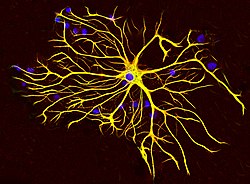
Back خلية نجمية Arabic Astrositlər Azerbaijani Астроцит Bulgarian Astrocit BS Astròcit Catalan Astrocyt Czech Astrocyt Danish Astrozyt German Αστρογλοιακό κύτταρο Greek Astrocito Spanish
| Astrocyte | |
|---|---|
 An astrocyte from a rat brain grown in tissue culture and stained with antibodies to GFAP (red) and vimentin (green). Both proteins are present in large amounts in the intermediate filaments of this cell, so the cell appears yellow. The blue material shows DNA visualized with DAPI stain, and reveals the nucleus of the astrocyte and of other cells. Image courtesy of EnCor Biotechnology Inc. | |
| Details | |
| Precursor | Glioblast |
| Location | Brain and spinal cord |
| Identifiers | |
| Latin | astrocytus |
| MeSH | D001253 |
| NeuroLex ID | sao1394521419 |
| TH | H2.00.06.2.00002, H2.00.06.2.01008 |
| FMA | 54537 |
| Anatomical terms of microanatomy | |
Astrocytes (from Ancient Greek ἄστρον, ástron, "star" and κύτος, kútos, "cavity", "cell"), also known collectively as astroglia, are characteristic star-shaped glial cells in the brain and spinal cord. They perform many functions, including biochemical control of endothelial cells that form the blood–brain barrier,[1] provision of nutrients to the nervous tissue, maintenance of extracellular ion balance, regulation of cerebral blood flow, and a role in the repair and scarring process of the brain and spinal cord following infection and traumatic injuries.[2] The proportion of astrocytes in the brain is not well defined; depending on the counting technique used, studies have found that the astrocyte proportion varies by region and ranges from 20% to around 40% of all glia.[3] Another study reports that astrocytes are the most numerous cell type in the brain.[2] Astrocytes are the major source of cholesterol in the central nervous system.[4] Apolipoprotein E transports cholesterol from astrocytes to neurons and other glial cells, regulating cell signaling in the brain.[4] Astrocytes in humans are more than twenty times larger than in rodent brains, and make contact with more than ten times the number of synapses.[5]
Research since the mid-1990s has shown that astrocytes propagate intercellular Ca2+ waves over long distances in response to stimulation, and, similar to neurons, release transmitters (called gliotransmitters) in a Ca2+-dependent manner.[6] Data suggest that astrocytes also signal to neurons through Ca2+-dependent release of glutamate.[7] Such discoveries have made astrocytes an important area of research within the field of neuroscience.
- ^ Suzuki, Yasuhiro; Sa, Qila; Ochiai, Eri; Mullins, Jeremi; Yolken, Robert; Halonen, Sandra K. (2014). "Cerebral Toxoplasmosis". Toxoplasma Gondii. Elsevier. pp. 755–796. doi:10.1016/b978-0-12-396481-6.00023-4. ISBN 978-0-12-396481-6.
Astrocytes are the dominant glial cell in the brain and numerous studies indicate they are central to the intracerebral immune response to T. gondii in the brain.
- ^ a b Freeman, MR; Rowitch, DH (30 October 2013). "Evolving concepts of gliogenesis: a look way back and ahead to the next 25 years". Neuron. 80 (3): 613–23. doi:10.1016/j.neuron.2013.10.034. PMC 5221505. PMID 24183014.
- ^ Verkhratsky A, Butt AM (2013). "Numbers: how many glial cells are in the brain?". Glial Physiology and Pathophysiology. John Wiley and Sons. pp. 93–96. ISBN 978-0-470-97853-5.
- ^ a b Wang, Hao; Kulas, Joshua A.; Ferris, Heather A.; Hansen, Scott B. (2020-10-14). "Regulation of beta-amyloid production in neurons by astrocyte-derived cholesterol". bioRxiv: 2020.06.18.159632. doi:10.1101/2020.06.18.159632. S2CID 220044671.
- ^ Cite error: The named reference
Sloanwas invoked but never defined (see the help page). - ^ "Role of Astrocytes in the Central Nervous System". Retrieved 27 July 2018.
- ^ Fiacco TA, Agulhon C, McCarthy KD (October 2008). "Sorting out astrocyte physiology from pharmacology". Annual Review of Pharmacology and Toxicology. 49 (1): 151–74. doi:10.1146/annurev.pharmtox.011008.145602. PMID 18834310.
© MMXXIII Rich X Search. We shall prevail. All rights reserved. Rich X Search